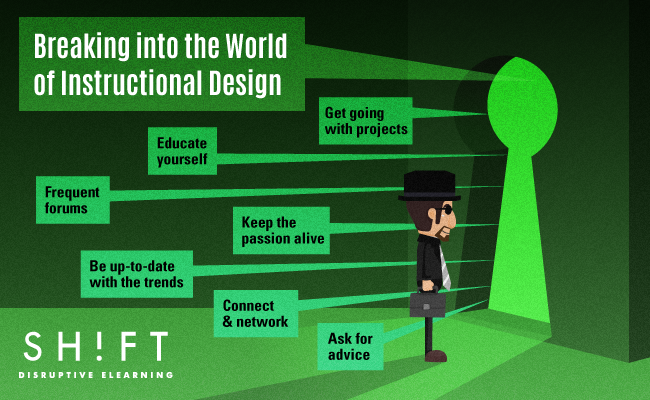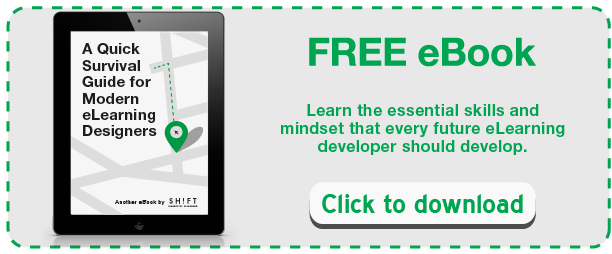What does an instructional designer do when he or she is at work?
He hobnobs with clients who may be life coaches, entrepreneurs, healthcare professionals, owners of production units, real estate magnates, or banking professionals.
He gets to read on and learn about a mindboggling array of subjects—self-development tactics, new software systems, fire safety, managing diseases and medical emergencies, flying an airplane, food packaging, and everything else under the sun.
He shares office with creative graphic designers and illustrators who make scenes and people come alive with their images, wordsmiths who paint pictures with their words, and maverick programmers who bring together the words and the pictures to create exciting courses.
He looks for inspiration in movies, video games, books, and toys.
There's never a dull moment at work for the instructional designer. And he gets paid to have the fun!
Do you want to be an instructional designer too? Here's how you can break into the world of instructional designing and carve a successful career out of it:
Tip # 1: Get Yourself an Education
The doctor had to go through the grind at the medical school. The lawyer went to a law college. The successful entrepreneur still takes management lessons. The artists and the writers attend workshops even if their works sell like hot cakes. Knowledge is power, and to be successful in a competitive world, you have to distinguish yourself with your learning.
Many colleges and universities offer eLearning courses. These are structured programs where you will receive plenty of guidance, get to interact with peers, and be assessed on your progress. But self-learning suffices. There are also plenty comprehensive resources on instructional designing. Here are a few to help you get going and get a hang of the thing:
Books
Start with the classics. The following books have more or less spelled out everything that is there to learn about instructional designing:
- Slide:ology by Nancy Duarte
- Better than Bullet Points: Creating Engaging eLearning with PowerPoint by Jane Bozarth
- Design For How People Learn (Voices That Matter) by Julie Dirksen
- e-Learning by Design by William Horton
- e-Learning and the Science of Instruction: Proven Guidelines for Consumers and Designers of Multimedia Learning (Essential Knowledge Resource) by Ruth Clark and Richard Mayer
Also, browse through the following lists for some more book recommendations:
- List by eLearning veteran and visual designer Connie Malamed on The eLearning Coach
- List of 50+ free books on designing in eLearning
- List of books that deal with general design guidelines and how the human mind learns
Online Courses
There are plenty of online courses for instructional designers. Here are a few formidable ones:
- Learn the Essentials of Instructional Design
- Storytelling for Designers
- The Neuroscience of Learning
- Instructional Design Essentials: Needs Analysis
- The ABCs of Instructional Design
Browse the Lynda and the Udemy sites because they have many other tutorials on offer, and they keep adding to their stocks!
More Online Freebies
The Internet is a minefield of information on everything you want to learn about designing eLearning courses. The following are some excellent resources by eLearning professionals who have been in the business for decades:
- Podcast by Connie Malamed
- The eLearning Coach, a blog by Connie Malamed
- Cathy Moore's blog, a resource bank created by an internationally-acclaimed training coach
- The Learning Technologies blog
- A List Apart, a design website
- Articles on design principles by the Learning Solutions Magazine
- Resources on eLearning Industry posted by professionals and industry thought leaders
- eLearning 101, an informative blog post to help you break into instructional designing
Tip # 2: Frequent Forums and Lap Up the Webcasts
Instructional designers are kind and helpful folks! Many of them work from home, and in between creating stellar storyboards and penning engaging scenarios, they come online to chat with aspiring designers. Find them on forums like the one maintained by the eLearning Guild.
Sometimes these folks share their knowledge and insights and provide tips via webcasts. Find these webcasts on ATD and eLearning Guild.
Tip # 3: Ask Around for Advice
If you have a friend who is an instructional designer or know someone who is a designer, ask advice from them. Ask them if you can watch them at work; there's no better way to learn than from examples. Remember to take copious notes and clarify your doubts from them at the end of the day.
Tip #4: Be Up-to-date with the Happenings and Trends in the Industry
Instructional designers have to be innovative. They also have to be on top of design and technology trends, so they can create instructionally sound, visually appealing, and technologically sound courses. Keep up with what's going on in the world of design with news and insights on sites like Smashing Magazine, DesignIsKinky, and Liquidicity.
Follow eLearning professionals like Connie Malamed, Clark Quinn, Patti Shank, and Brent Schlenker on their blogs social media handles to keep up with industry trends.
Find your inspiration from designers who have perfected the art of communicating to diverse audiences. Hear them speak at conferences. Keep track of these events on ATD and eLearning Guild.
Tip #5: Reach Out, Connect, and Network
Now that you have been learning for some time, get out there and connect with your peers. It is also time you did some professional networking and let recruiters know you are ready for the job market. Develop a strong digital footprint, make real connections and learn all you can about the ed-tech space
LinkedIn, Twitter, and meetup.com are some places where you can hobnob with designers and thought leaders, take part in the conversations, and make yourself heard and be counted. You can also meet other designers at Skillshare-like events. Also follow local business owners; be sensitive to their training needs. Sometimes they might not realize an eLearning course can resolve their training requirements; this is where you step in, so always be on the lookout for hints they drop.
Network with your peers as well. You never know when they might need someone to pitch in and help them manage their busy schedules and overflowing workload. Besides, peers can also direct you to lucrative gigs that they can't take up themselves.
Be patient; all these connections will eventually lead to referrals and other business opportunities.
Tip #6: Get Going with Projects Even if They Are DIY Tasks
Recruiters always choose individuals who walk the talk. So you will need a portfolio handy. Volunteer at non-profit organizations and offer to design their courses. Track them on Yelp, Craigslist, and Volunteer Match and pitch your skills. If you show the commitment, they will be happy to let you help. You may be paid peanuts (that is, if you are paid at all) but the experience you gain will be invaluable.
If you cannot land any opportunity, create your own projects. Give vent to your creative juices and create a course that carries the stamp of your enthusiasm and passion.
Once you have a portfolio to show for your talents, approach local businesses. You may have to work at prices less than the market rate, but be patient. Once you have a robust portfolio and recommendations, you will land higher-paying jobs.
Final Tip: Keep the Passion Alive
Passion. That's one quality recruiters value greatly, and sometimes they consider it more important than experience and expertise. Keep showing your enthusiasm. Let your passion show in your work. You will soon attract recruiters.
CONCLUSION:
When you are trying to break into the world of instructional designing, you need the backing of sound technical and design knowledge and should be armed with a stellar and diverse portfolio. These will need some preparation, so start today.









